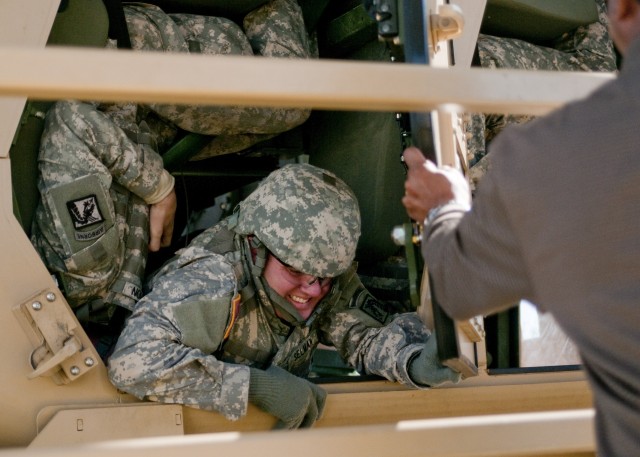
FORT BRAGG, N.C. - "It saves lives, I can't tell you how many lives its saved, but I can tell you that we don't have near as many rollover deaths like we used to," said Michael Taylor, Virtual Training Facility manager. "You have a 250 percent chance of surviving a rollover going through this device."
For high-mobility, multipurpose wheeled vehicle egress assistance training instructors, it's not about the thousands of dollars the Army saves with the simulator, it's about the hundred of lives saved by what the simulator teaches each servicemember that goes through it before deployment.
The HEAT simulator is an M1114, or uparmored humvee, frame mounted on a 360-degree rotation axle that when in operation, simulates a rollover situation.
"(This training was enacted) as a directive from CENTCOM (Central Command) because we were losing too many Soldiers in rollovers due to the terrain or condition of the roads overseas," said Taylor. "In the middle of the night with all your battle rattle on, it's very easy for panic to set in."
According to Jeffrey Secrest, a HEAT instructor, going through the simulator is mandatory for predeployment training that every Soldier, Sailor, Marine and Airman must go through before deploying and it consists of class instruction by a certified unit instructor and explains the four basic battle drills.
"The four mandatory battle drill scenarios include the two critical rollover angles, which is how far you can go before you rollover. We take them to those angles in hopes they'll remember downrange to prevent an accident," explained Secrest.
"Then we roll them over 360-degrees for up to three full rotations so they can brace themselves, hold the gunner who is in the turret and secure their weapon. Then we take them through two worse case scenarios, one dry land scenario and one simulated rolling into water so they know how to react (during the accident).
"The best thing that it does is that it builds muscle memory so when it happens (the Soldiers) don't have to think about it, they just react. We've even had Soldier's rollover in (their personally own vehicles) and be able to react to it because of this training," Secrest continued.
"The trainer gives them the ability to react and learn the actions so that it's muscle memory, because unless you've been in a rollover or the simulator, you really don't know what to expect," he said.
"I'd say HEAT serves two major purposes," said Taylor. "One, it mitigates safety on the battlefield and makes the Soldier more conscience about safety and secondly, it also gives the Solider a survival skill. To me that would be a individual Soldier skill asset that everyone needs to know."
Fort Bragg got its first virtual weapons training system, the Engagement Skills Trainer, in 2002. The Virtual Training Facility received its latest addition recently - the Reconfigurable Vehicle Tactical Trainer which provides 360-degree coverage of training dealing with a humvee.
"It's as real as you can get without someone shooting at you," said Taylor. "Virtual training has finally gotten down to the Soldiers' level, where it should be, according to Army doctrine, techniques, tactics, and procedures downrange. It doesn't replace hands-on training but all the virtual training we can give (a Soldier) reduces the learning curve when they go out and do live fire exercises and certainly reduces accidents and deaths on the battlefield and that's our main objective here."
The HEAT trainer has cycled around 500 to 1,000 servicemembers since beginning operation in September of 2008.
"We have the capability of running an average of 80 people through one machine in one day," said Secrest.
All of the HEAT trainers, are contracted through the Logistics Company, are retired military, have some sort of training backgrounds and all were drill sergeants. The HEAT trainers will certify Soldiers at the unit level so that those Soldiers can train their unit on the procedures. The HEAT trainers will also be present during the training to ensure it is done to standard and serve as extra safety checks.
"The simulator isn't as violent or as fast as an actual rollover, due to safety, but we have different scenarios that we teach to get them out quickly and safely," said Secrest. "A way of looking at it is that the system saves the Army money if you take into account the cost of damages to the vehicle, the equipment inside, and the Soldiers' lives or injuries, but most importantly, lives."

Social Sharing